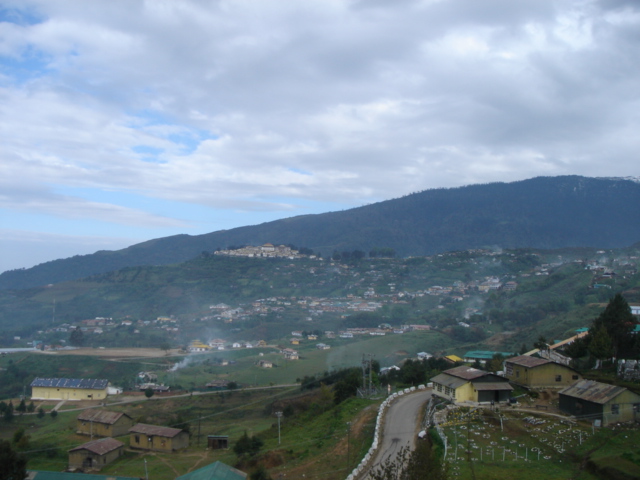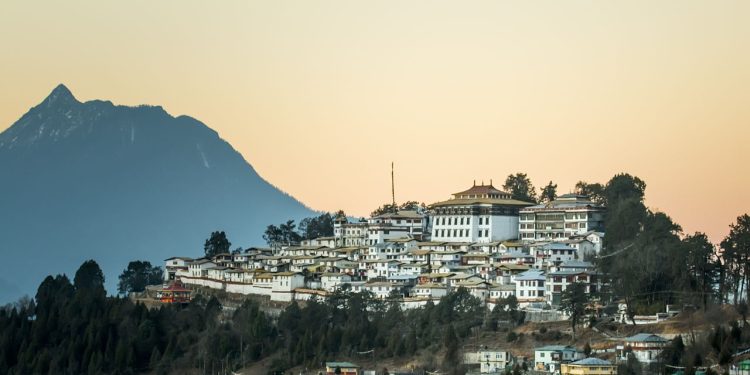Tawang Monastery is known in Tibetan as Galden Namgey Lhatse, which translates to “celestial paradise in a clear night.” It was founded by Merak Lama Lodre Gyatso in 1680-1681 in accordance with the wishes of the 5th Dalai Lama, Ngawang Lobsang Gyatso. It belongs to the Gelug school of Mahayana Buddhism and had a religious association with Drepung Monastery of Lhasa, which continued during the period of British rule.
Shrine’s History
The monastery was founded by Merek Lama Lodre Gyamsto in 1680-81 at the behest of the 5th Dalai Lama, who was his contemporary. When Merek Lama was experiencing difficulties in building the monastery at the chosen location of Tsosum, the ancient name for Tawang, the 5th Dalai Lama issued directives to the people of the area to provide him with all help. To fix the perimeter of the Dzong, the Dalai Lama had also given a ball of yarn, the length of which was to form the limit of the monastery. Prior to the dominance of the Gelug sect of Buddhism in Tawang, the Nyingmapa or the Black Hat sect of Buddhism was dominant and this resulted in their hegemony and even hostile approach towards the founder, Merek Lama. This problem was compounded by the Drukpas of Bhutan, who also belonged to the Nyingmapa sect, who even tried to invade and take control of Tawang.
Hence, when the Tawang monastery was built like a fort structure, a strategic location was chosen from the defence point of view. In 1844, Tawang Monastery had entered into two agreements with the East India Company. One agreement, signed on 24 February, pertained to surrender by the Monpas of their right to the Karlapara Duar in return for an annual fee of Rs 5,000, and another, dated 28 May, related to the Shardukpens to abide by any order of the British administration in India in return for an annual fee of Rs 2,526 and seven annas. Tawang officials used to travel almost to the plains of Assam to collect monastic contributions.
According to Pandit Nain Singh of the Trigonometrical Survey of India, who visited the monastery in 1874-75, the monastery had a parliamentary form of administration, known as the Kato, with the Chief Lamas of the monastery as its members. It was not dependent on the Dzonpan and Government of Lhasa, and this aspect was supported by G.A. Nevill who had visited the monastery in 1924. Until 1914, this region of India was under the control of Tibet. However, under the Simla Agreement of 1913-14, the area came under the control of the British Raj. Tibet gave up several hundred square miles of its territory, including the whole of the Tawang region and the monastery, to the British. This disputed territory was the bone of contention for the 1962 India-China war, when China invaded India on 20 October 1962 from the northeastern border, forcing the Indian army to retreat.
They occupied Tawang, including the monastery, for six months, but did not desecrate it. China claimed that Tawang belonged to Tibet. Before this war, in 1959, the 14th Dalai Lama had fled from Tibet, and after an arduous journey crossed into India on 30 March 1959, and had reached Tawang and taken shelter in the monastery for a few days before moving to Tezpur. 50 years later, in spite of strong protests by China, the Dalai Lama’s visit on 8 November 2009 to Tawang Monastery was a monumental event to the people of the region, and the abbot of the monastery greeted him with much fanfare and adulation. As of 2006, the monastery had 400 monks, and the number was reported to be 450 in 2010. Tawang Manuscript Conservation Centre was established in the monastery in August 2006, which has curated 200 manuscripts, and 31 manuscripts have been treated for preservation.
In November 2010, it was reported that the monastery is threatened by possible landslide risk, with The Times of India reporting “massive landslides around it”. Professor Dave Petley of Durham University in the United Kingdom (UK), an acknowledged landslide expert, wrote: “the northern flank of the site appears to consist of a landslide scarp … The reasons for this are clear ? the river, which flows towards the south, is eroding the toe of the slope due to the site being on the outside of the bend. In the long term, erosion at the toe will need to be prevented if the site is to be preserved.” The monastery currently has control over 17 gompas in West Kameng district.
The monastery has administrative control over two dzongs, each headed by a monk; the Darana Dzong built in 1831 and the Sanglem Dzong, also known as Talung Gompa, in the south-west part of Kameng district. These dzongs not only collect taxes but also preach Buddhism to the Monpas and Sherdukpens of Kameng. The monastery owns cultivable lands in the villages of Soma and Nerguit and a few patches in some other villages which are tilled and cultivated by farmers, who share the produce with the monastery.The present resident head of the monastery is the incarnate Gyalsy Rinpochey

Shrine’s Map Location and How to Go There
By Road
The nearest Bus stop is Tawang
By Rail
The nearest railway station is at Naharlagun.
By Air
The nearest airports are at Salonibari Airport in Tezpur and Lokpriya Gopinath Bordoloi International Airport, Guwahati
Events Celebrated at This Shrine
The main Monpa festivals held in the monastery are the Choksar, Losar, Ajilamu, and Torgya. Choksar is the festival when the Lamas recite religious scriptures in the monasteries. Following the religious recitations, the villagers carry the scriptures on their back and circumambulate their agricultural land seeking blessings for a good yield of crops without any infestations by pests and to protect against attack by wild animals. In the Losar festival, which marks the beginning of the Tibetan New Year, people visit the monastery and offer prayers. Torgya, also known as Tawang-Torgya, is an annual festival that is exclusively held in the monastery. It is held according to the Buddhist calendar days of 28th to 30th of Dawachukchipa, which corresponds to 10 to 12 January of the Gregorian calendar, and is a Monpa celebration. The objective of the festival is to ward off evil spirits and ushering all round prosperity and happiness to the people in the ensuing year. During the three-day festival, dances performed by artists in colourful costumes and masks are held in the courtyard, including the Pha Chan and the Losjker Chungiye, the latter of which is performed by the monks of the monastery. Each dance represents a myth and costumes and masks represent animal forms such as cows, tigers, sheep, monkeys and so forth






































